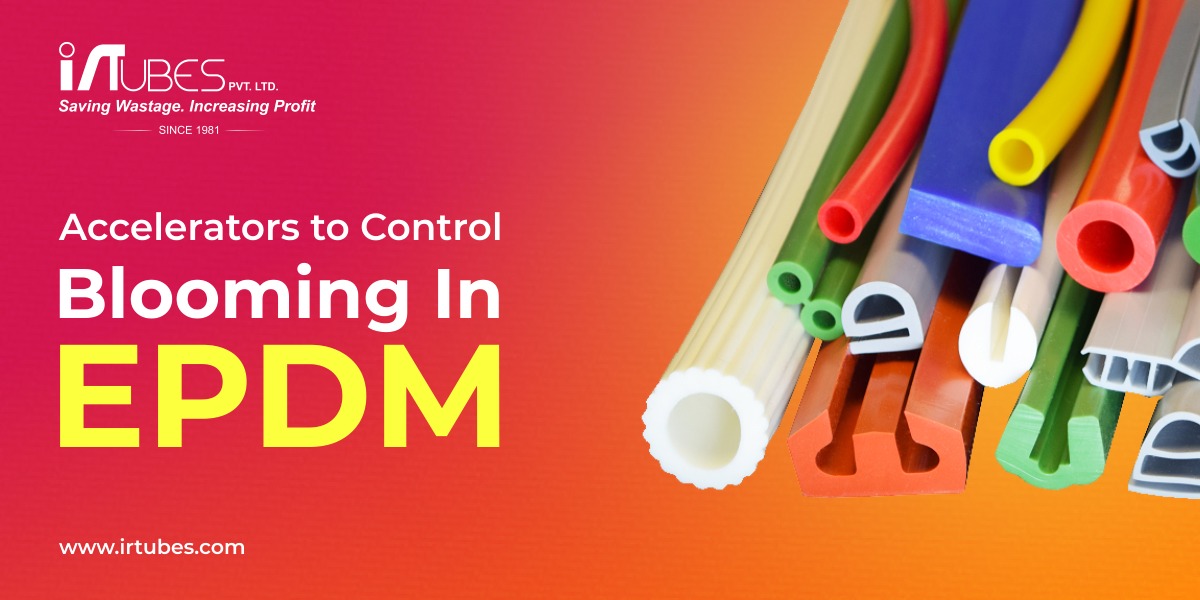
‘Smartly’ use pre-mixed accelerator blends to control blooming
Curing in EPDM (Ethylene propylene diene) rubbers is much slower compared to curing in conventional diene rubbers. Therefore, it usually requires a high concentration of highly active curing accelerators. This, though, has its own issues as there is a limit to using high amounts of accelerators, as their activity tends to level off with increased concentration and BLOOMING problems start.
EPDM is a terpolymer with side-chain double bonds. The main chain thus remains saturated. The advantages of the EPDMs largely saturated molecular structure e.g., high resistance to weathering and ageing, are accompanied by a relatively inert vulcanization characteristic.
Simple accelerator systems find it challenging to simultaneously adjust a delayed onset of cure, rapid full cure, and a high degree of crosslinking. The solution lies in a combination of four or more different accelerators and sulphur donors. However, the concentration in which each active ingredient is used is key, coupled with the different grades in EPDM rubber. If the components are not optimally balanced, fogging or blooming effects can appear on the surface of the vulcanized material. The use of pre-mixed blends with optimized curing properties offers an elegant solution to this problem.
To achieve a high degree of cross linking in a short time, highly active accelerator systems are often applied, which are based on thiurams and dithiocarbamates. However, during the process, these single accelerators can split off secondary amines which can be turned into nitrosamines under the presence of nitrogene oxides. Nitrosamines are known to have carcinogenic effects and are very harmful.
In this two-part series we present you with TWO optimized multi-purpose accelerators blends with high cure activity. Such mixtures are easier and safer to handle, to weigh and to incorporate compared to several individual components, whilst rationalizing inventories. These accelerator blends, in either powder or granulate form, allow for easy integration, and demonstrate a high level of process-reliability.
DEOVULC EG 3
Composition: Combination of highly active accelerators. Available as a non-dusting powder or as granules.
This grade is a balanced accelerator blend for rubber products that must not show any blooming or staining effects. Its characteristic profile is for fast vulcanisation with a wide spectrum of usages.
| Dosage Guidelines (phr) for EPDM | ||
| Black Compounds | Light coloured compounds | |
| Deovulc EG 3 | 3 – 5 | 5 – 6 |
| Sulphur | 1 – 2 | 1 – 2 |
Effects of Increased Dosage



Conclusion: The effects of increased dosage of Deovulc EG 3 with a constant amount of sulphur are mainly revealed in the shortened time to full cure (t…).
Physical Properties



Conclusion: Even at a dosage of 3 phr, excellent physical properties are achieved, while as expected, the tensile strength decreases with the concentration of accelerator and the hardness increases slightly. Starting at a dosage of 3 phr, a good level of physical values is reached. Merely the addition of only 2 phr Deovulc EG 3 leads to under-vulcanisation, which is clearly reflected in the compression set and the heat ageing.
Effects of Sulphur Dosage



Conclusion: When interpreting the values of the rheometer, it is important to take all the measurement results into consideration. The measurement with a dosage of 0.5 phr sulphur at first may appear to lead to a very fast vulcanisation. However, that can lead to the oversight, that the degree of cross linking (seen in the maximum torque appears only at low levels. Adequately high-level values are only reached at 1 phr or more. The differences which are then noticeable, fulfil expectations.
Physical Properties



Conclusion: Depending on the usage, one can significantly influence the compression set or the modulus by varying the sulphur dosage.
Effects of Secondary Accelerators



Conclusion: The test results show that Deovulc EG 3 is excellently suited for usage in EPDM. The most commonly tested secondary accelerators show no significant improvement. The addition of Deovulc ATP -70 enables a faster curing.
Physical Properties



Conclusion: The physical-mechanical properties also show that one can achieve highly balanced characteristics by using Deovulc EG 3. In terms of mechanical properties, no significant improvement is possible with the common secondary accelerators.
SUMMARY AND CONCLUSIONS
The use of Deovulc EG pre blended accelerators in EPDM compounds has been proved to offer practical and technological advantages compared to working with several individual accelerators. Although the accelerator blends have been largely optimized by D. O. G, the manufacturer, they leave the rubber compounder sufficient freedom for individual development efforts.
In the month of January 2023, we bring to you another accelerator BG 187 V. With that we will have concluded our two-part series on Deovulc pre-blended accelerators.
I R Tubes Pvt. Ltd. is a leading specialty chemical suppliers for the chemical industry. Contact I. R. Tubes on info@irtubes.com or Call: 9689927193 for more information
Raju Jethmalani
IRTubes Pvt. Ltd., Pune
Share on:
